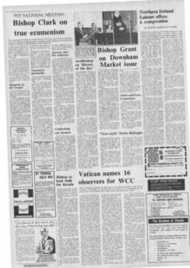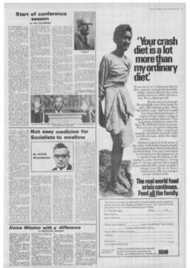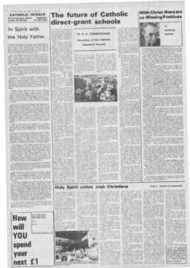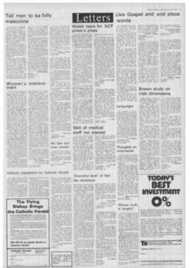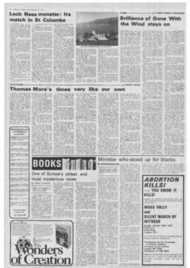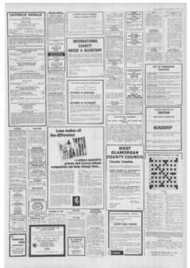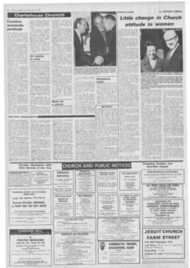Page 8, 26th September 1975
Page 8
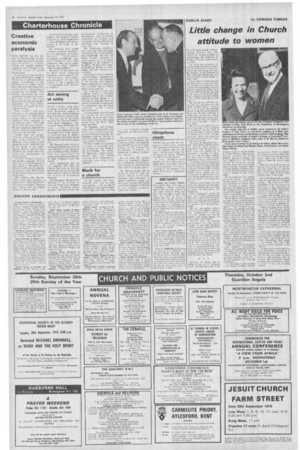
Report an error
Noticed an error on this page?If you've noticed an error in this article please click here to report it.
Tags
Share
Related articles
Strong Journalistic Meat
Collapse Of A Vital Conference
Mission Sunday Is More Than Just A Cash Collectiop
Third World Lobby
From Neutrality To
Creative economic paralysis
THIS MONTH for the first time the British public can buy from their news stands the New Internationalist a hardhitting and readable monthly magazine which focuses on the critical issues of world development.
It is produced each month in the quiet Oxfordshire village of Benson by a small team whose expert presentation of the problems of the global village have earned for the magazine a world-wide subscription readership of 20,000. This healthy circulation has now convinced retailers of its commercial value. So from September 29. with the October magazine. the New Internationalist will appear on newsagents shelves.
Each month it will concentrate on one special subject so that readers can build an upto-date library on the crucial problems facing mankind. In the October issue, The Case for the New Economic Order". the poor countries' demands for a better deal and their chances of success are stressed.
Future issues will include: "Yes, but what can I do?" (the man in the street's way of helping), "The world in your shopping basket" ((he real cost of the goods on the supermarket shelves), and an issue featuring the world's best cartoons and photographs on social change.
As Peter Adamson writes in the October magazine: "Weyer there was a tide in the affairs of men. this is it. The earth community stands before a gathering storm of crises. And it knows it: 460 million people are actually starving." On a lighter note, the October issue also contains a special free "jargon generator" which invites readers: "Astound your friends with an endless stream of glib phrases." At the turn of a circular card readers can produce literally hundreds of useful expressions many of which would enliven debate at all levels of the Church.
For example, how would "creative economic paralysis" do as a description of Church finance? "Ambivalent ideological consultation" may sound familiar to Latin Mass supporters, who are no doubt longing for more "positive issue-oriented publicity. '
But surely all will agree that we must avoid "ongoing ecumenical disorientation" and "bureaucratic doctrinaire relationships." In the last analysis it's all a question of "co-ordinated unstructured guidelines."
MANY Catholic clergy have accepted invitations to speak from Protestant pulpits in Scotland, hut return invitations from Catholics are still awaited.
This was one of the points made by the Viennese Catholic artist Ernst Degasperi, who returned from Edinburgh this
week after running simultaneous exhibitions at the Canongate Kirk of the Church of Scotland and St Mary's Episcopalian Cathedral during the festival in Scotland's capital city.
Mr Degasperi said Church of Scotland people he had met had been shocked by the reception given to Bishop Daly of Derry. who was prevented by demonstrators from speaking at St Giles' Cathedral early this month.
They emphasised that the vast majority who filled the Church had come to hear the bishop and the very fact he had been asked to speak at all was an advance in ecumenical relations.
Mr Degasperi, who gives exhibitions of his drawings all over the world in his campaign to bring Christians closer together, and has already had simultaneous exhibitions in Protestant and Catholic cathedrals in London and Liverpool, said his reception in Edinburgh was "fantastic in every way."
The Edinburgh exhibition was under the joint patronage of Cardinal Gray of St Andrews and Edinburgh: the Rev Dr Selby Wright, minister of Canongate and former Moderator of the Church of Scotland; Dr Kenneth Carey. Episcopalian Bishop of Edinburgh, and the Austrian ambassador.
It attracted a lot of attention from the media, including three radio interviews and publicity in the secular and religious Press, Demand for catalogues was so great that a second printing was ordered.
Mr Dcgasperi said the Catholic Church in Scotland reminded him of the Catholic Church in East Berlin in both places. Catholics were in a minority and had a strong sense of community, hut not much contact with other denominations.
A total of more than A/ yards of stands of the artist's drawings, in black and white and multi-coloured, illustrating scenes from the Bible, filled both churches.
Mr Degasperi said Cardinal Gray, after viewing them, told him he was touched to see that so many featured Our Lady. Mr Degasperi said the Mother of God was rarely represented in non-Catholic Churches.
He has accepted an invitation to return to Edinburgh next year to show his latest works at the Episcopalian Art Centre, Mr Degasperi, a bible scholar himself, said: "The written word can divide Christians but drawings can bring them together "
In the simple old days, churches were built for only one purpose the worship of God. But our soft age has begun to alter this, and today we read
blog comments powered by Disqus



